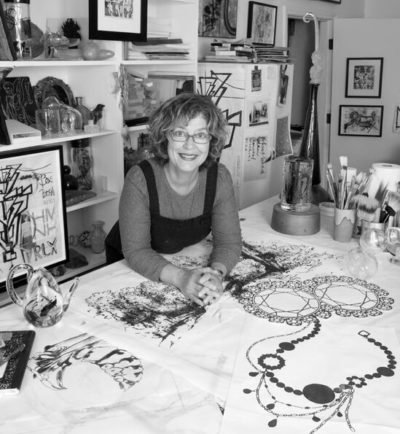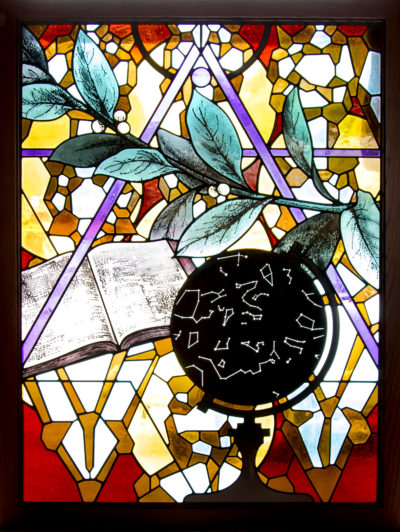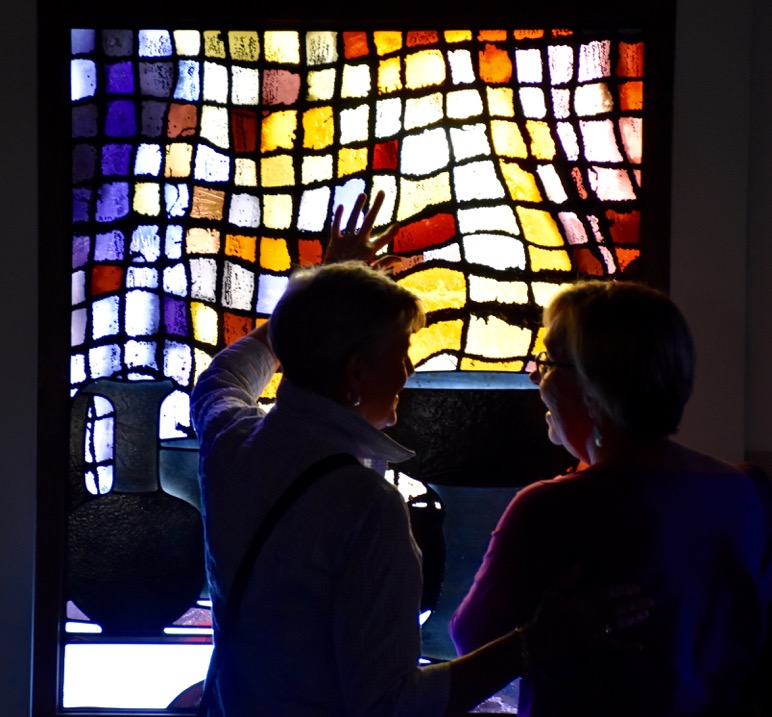COMMUNITY | By Robin Gerber
‘Beshert’ Comes Home
What if you made a piece of art, make that six unique, metaphorical, transcendent pieces of glass art, and you sold them to a place thousands of miles from your home. And then, somehow, those works of art came back to you? They came to your little town, to a location where they fit to perfection. They came to people who loved them in a special way.
Some people would call it a miracle. In Yiddish, it would be called ‘beshert,’ or destiny.
Our story starts with a love of glass, in the Ojai studio of Susan Stinsmuehlen-Amend. It’s a place full of light and glass pieces, tools, pencils, paints and drawings. A working space crowded with years of creativity.
Susan holds up a piece of glass for me, its surface shining like her blue eyes. The light pours through the subtle ripples on its surface as she remembers the first time she saw glass cut. “I thought, ‘Whoa, what is this?’ You just take a glass cutter with a tiny little wheel, and scratch it across a piece of glass, and then take it in your fingers and break it. That was like a miracle to me. Breaking glass in a controlled way.”
Susan lays a small piece of glass next to me on the worktable where we’re sitting on tall stools. She takes a small tool, with a sharp point and tiny wheel, and slides it down the glass. She doesn’t seem to be pressing hard, but in a second she picks up the glass, and I hear the sharp, clean crack as it breaks along her line. I see what she means by “miracle.”
“The glass itself works with light,” Susan says, “and it is pure color. You can put it together and have light come through it. When I first saw the possibilities, it was so amazing. And there were optics because there were so many kinds of glass. There’s opaque, transparent, and hand-blown, which is super beautiful. There’s ‘flash’ glass, where you can sandblast off a layer, and get a clear or white effect.” Susan holds up a piece of blue glass with a kind of round white snowflake design in the middle. It’s both surprising and bold, like the artist.
Susan was that smart, troublesome child who parents adore, and who drives them to drink. “I always had a struggle with the rules,” she says, “and with standards that are put on people that didn’t make sense to me. There was a rule-breaking part of me, and that’s not atypical of artists. And struggles at home are not atypical, because you see the world differently and your family doesn’t understand.”
Susan built her national reputation on breaking the rules about stained glass. “I used traditional 12th century techniques in a new way,” she explains. “When it comes to leaded glass, I tried to hide the lines, because I felt they needed to be accountable if they stood out.”
In the late 1970s, Susan created her “fragmented X” series, a symbolic depiction of crossing out old ways of working with glass. Her distinctive work became part of major collections, including the American Craft Museum. When that museum’s director, Janet Kardon, was asked to recommend a glass artist to the New York Jewish Museum, Susan was at the top of the list.
It was early 1992, when Susan got the call from the Jewish Museum in New York City. They were renovating, and a new café was in the works. Being in the basement, it had no windows, but the architects had designed six openings for light boxes, each about four by three feet.
Twelve “blessings,” was the theme for the stained glass panels that the Jewish Museum wanted Susan to make for the front of the boxes. Inside the boxes, artificial light would illuminate the glass. Museum staff sent research, text and Old Testament readings to get Susan started on the design process. She hoped to both poetically and metaphorically show the idea of the blessings entrusted to her.
Susan developed drawings for the museum’s consideration. She dove deep into research on Jewish tradition, spending time at the Skirball Museum in L.A. She sent designs, and re-did those designs, and re-did them again. “I have never done as many proposals for a commission,” Susan laughs.
Susan flew to Oakland to pick out hand-blown European sheet glass. “It was expensive, and gorgeous,” she remembers, “but I felt there was a place for manufactured glass, and if I could combine them in a certain way it would create a dialogue between high and low.”
Susan chose her former fifteen-year business partner, Rodney Smith, at Renaissance Glass, Co., in Austin, Texas, to fabricate the windows. “I drew the full-sized patterns, and flew to Texas to label each piece of glass, and designate how it would be cut.”
A third of the glass was painted with glass-like enamels. It was then fired in a kiln to permanently fuse the paint to the surface. Flashed-glass was sandblasted to create two-tones within one piece. And then came the lead work. Susan explains, “We, at the studio, came up with intricate methods of carving and combining thick and thin lead to create dynamic lines within the overall image.”
Finally, in January, 1994, nearly two years after Susan got the commission, the windows were installed in their stained hard-oak boxes in the Jewish Museum’s new Café Weissman.
That same year, in Susan’s hometown of Ojai, a small group of Jewish people, including Ellen Sklarz, was forming the first Jewish community.

Ojai artist Susan Stinsmuehlen-Amend, photo by Cindy Pitou-Burton.
Flash forward to December, 2013. Barbara Hirsch, one of Ojai’s major art patrons, was in New York for her cousin’s funeral. Art was her passion and solace, so to offset her sadness she went to the nearby French Gothic chateau on Fifth Avenue that houses the Jewish Museum. “I’d never been there before,” Barbara recalled. “It was snowy and cold, but I went anyway, and had lunch at the Café Weissman.” As she ate, Barbara remembers being “dazzled” by the unusual, modern stained glass around the room.
There, Barbara saw, shimmering with backlight, ancient ceramic vessels in silhouette against a waving “fabric” of warm colored glass squares, suggesting the blessing over bread and wine. Another window showed a wintry black tree with tiny buds, seen through a honeycomb with seven flames floating in the foreground. It depicted blessings over fruits of the trees and produce of the earth.
Barbara got up from her lunch and walked closer, fascinated by the window with bright red poppies, white lilies and an olive branch against a background of richly colored circles. This was the blessing over spices, flowers and herbage. On another window, she saw Jacob’s ladder, a shofar and astrological symbols against a blue sky, meant to call to mind blessings upon receiving good tidings and bad tidings.
Barbara started taking pictures to share with others at the temple in Ojai. They were about to start on a building renovation. Perhaps they could think about replacing the jalousie windows of their old building, a former Baptist Church, with something like these glorious panels?
Barbara took a picture of the window showing prismatic jewels seeming to tumble from the glass, which suggested the blessings from thunder, earthquake and falling star. And the window with an intricate interplay of light and dark, which included an open book, a globe with a celestial map and a myrtle branch, evoked blessings for Torah wisdom and secular learning.
Then Barbara walked close enough to read the plaques. “I was shocked to see that my dear friend and colleague, Susan Stinsmuehlen-Amend, was the artist,” Barbara said. The two women served together on the Ojai Arts Commission. “I was so surprised and delighted, I immediately sent her a text with my discovery.”
And somewhere in the back offices of the Jewish Museum, discussions were underway to renovate the Café Weissman.
Eight months later, Susan got an email from the Jewish Museum. She was dismayed to read that they were going to de-install her windows. She had thought that they were part of the permanent collection. But then she read, “Rather than putting them in storage, we would like to explore options for finding them a worthy new home. We would also be very interested in gifting them to another institution.”
Susan had an idea. She emailed her friend Sklarz, who she knew was a member of the Jewish temple in Ojai. “Ellen, Just got info that my six panels of leaded glass in the Weissman Cafe at the Jewish Museum will be coming out due to a remodel. The works may be up for donation to another institution. Was wondering about the local synagogue?”
A few weeks later, Susan and Ellen were meeting at Barbara Hirsch’s house, with Alan Greenberg, who was heading up the Ojai temple renovation. They looked at each other in stunned amazement. They could hardly believe the Temple’s good fortune. Having seen the windows in person, Barbara was beyond thrilled. “I knew that this gift would add a new dimension to our temple,” Barbara said, “and start our effort to develop an art collection of note.”
Susan had guided the windows to the temple at just the right moment. The main sanctuary was being “refreshed,” and already had a large stained glass work, called “Torah/Tree of Life” adorning the ‘bimah’ or stage.
On April 15, the windows, carefully crated by the Jewish Museum, were put on a shuttle with a fine arts shipper, set to arrive in Ojai on April 28th.
The six boxes were laid flat in the new, unfinished social hall. Alan Greenberg and Peter Thielke, cordless electric drills in hand, began unscrewing the drywall screws from the top panel of one of the plywood crates. Barbara and Ellen, and a few other members of the congregation held their breath as the rigid foam was taken off the first window. Very gingerly, Peter and Alan lifted it out.
Alan remembers feeling stunned by the color and intense beauty of the window. He and Peter held it up to the light.
Ellen remembers thinking of how far the Temple had come. “I was among a group of temple founders. At our first High Holy Day services we sat on folding chairs, and the prayers were led by a Hebrew Union College rabbinical student with a ponytail and Birkenstocks. Soon after we opened, a swastika was painted on the door. Many people in the community, including pastors from various churches came out for a ceremony to paint over it. So, it was glorious to get those beautiful panels in what had started as such a funky little temple.”
But how would the panels be installed? The windows were not the exact size of the openings. The cost to retrofit the windows was daunting. And then the final miracle occurred. Another local artist, and Temple member, made a large anonymous donation so that the windows could be placed where they seemed to have always belonged. It was ‘beshert.’
On October 19, 2016, the Jewish Community of Ojai unveiled its miracle to the City. The sanctuary was full of residents of every faith as the story of the windows was told. But the last chapter had yet to be written.

Stained glass by Ojai artist Susan Stinsmuehlen-Amend
Susan’s stained glass didn’t fill all of the window openings in Ojai’s temple, and the congregation didn’t have the money to commission more. It took two years of trying, but last December the Temple had raised enough money — including a grant from the Jewish Federation of Ventura — to have Susan create two more of her glorious windows.
As Barbara Hirsch says,
“Ojai is a place where art flourishes, and the community embraces art
Ojai is also a place of miracles that are sometimes “beshert.” ≈OQ≈


Leave A Comment